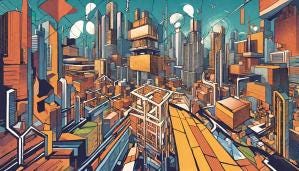decentralization – why mankind won’t ever be fully decentralized
In recent years, the concept of decentralization has gained momentum, with technology and political movements advocating for a future where power is distributed among the many rather than concentrated in the hands of a few. The allure of decentralization is clear: it’s about empowerment, autonomy, and the elimination of centralized control. However, while the idea of a fully decentralized society sounds appealing, there are deep-seated reasons why we may never achieve this goal. This article explores the historical context, the inherent human tendencies, and the practical challenges that make complete decentralization unlikely, if not impossible.
The Cycles of Centralization and Decentralization
Human history is marked by cycles of centralization and decentralization. From ancient civilizations to modern societies, we see patterns where power is concentrated, then dispersed, only to be re-concentrated later. This ebb and flow are driven by several factors, including technological advancements, socio-political dynamics, and economic shifts.
In ancient times, societies were generally decentralized. Early human communities were small, with power spread across family groups or tribal structures. However, as these groups grew, so did the need for organization and coordination. This led to the formation of early kingdoms and empires, with centralized leadership to manage resources, defend against external threats, and maintain social order.
Over time, centralized structures would become too rigid or corrupt, leading to their collapse. This collapse often resulted in a period of decentralization, where smaller groups or regions regained autonomy. Yet, the need for stability and efficiency would eventually push societies back toward centralization. This cyclical pattern suggests that while decentralization has its merits, it’s not a permanent state.
Human Nature: The Drive for Hierarchy
Another factor that makes full decentralization challenging is human nature. As social beings, humans tend to form hierarchies. Even in small groups, certain individuals naturally rise to leadership roles due to their skills, charisma, or other qualities. This inherent tendency toward hierarchy means that complete decentralization is difficult to maintain.
Studies on group dynamics reveal that people often prefer clear leadership, especially in times of uncertainty or crisis. When faced with complex challenges, individuals tend to rely on those who appear more knowledgeable or capable. This reliance creates power dynamics, where leaders emerge and influence the group’s direction.
Moreover, people often seek convenience and efficiency. Centralization offers a streamlined way to make decisions and coordinate activities. While decentralization promotes autonomy, it can also lead to redundancy, miscommunication, and inefficiency. Thus, even in decentralized systems, there is a tendency to centralize certain functions to maintain coherence and effectiveness.
Practical Challenges: Infrastructure and Coordination
Decentralization poses practical challenges that can be difficult to overcome. In a fully decentralized society, coordinating large-scale projects or maintaining infrastructure becomes complicated. Centralization allows for the efficient allocation of resources and the coordination of complex tasks. Without some degree of centralization, societies may struggle to build and maintain critical infrastructure like roads, bridges, and public services.
Furthermore, decentralization can hinder collective action. Addressing global issues such as climate change, pandemics, or economic crises requires coordinated efforts across multiple regions and governments. Centralization provides a mechanism for collective decision-making and resource mobilization, enabling societies to tackle large-scale problems more effectively.
Technology and Decentralization: Opportunities and Limitations
Technology has played a significant role in promoting decentralization. The rise of the internet, blockchain technology, and peer-to-peer networks has enabled greater autonomy and reduced the need for centralized intermediaries. These technologies empower individuals to connect directly with one another, share information, and conduct transactions without relying on centralized authorities.
However, even with technological advancements, complete decentralization remains elusive. Centralized entities often find ways to adapt and maintain control. For example, while blockchain technology enables decentralized finance (DeFi), centralized exchanges and platforms still dominate the cryptocurrency landscape. Similarly, while the internet allows for decentralized communication, major platforms like Google, Facebook, and Amazon hold significant power and influence.
Conclusion: Embracing the Balance
While the vision of a fully decentralized society is intriguing, history, human nature, and practical challenges suggest that complete decentralization is unlikely. Instead, societies will continue to navigate the balance between centralization and decentralization, finding ways to leverage the strengths of both approaches.
Decentralization offers autonomy, empowerment, and innovation, while centralization provides stability, efficiency, and coordination. By embracing this balance, we can create systems that are resilient and adaptable, meeting the needs of individuals and communities while addressing broader societal challenges.
Ultimately, the journey toward decentralization is a continuous process, with new technologies and ideas shaping the way we organize and interact. While we may never achieve full decentralization, the pursuit of a more decentralized world can lead to a more equitable, inclusive, and empowered society.

